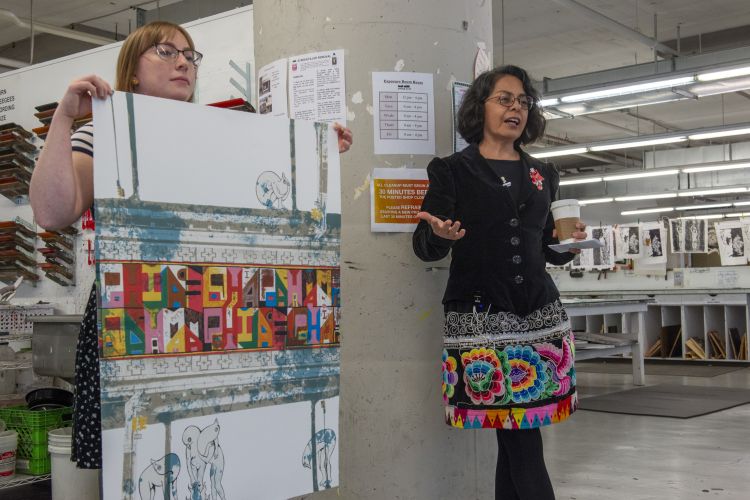STORIES FROM PAFA
Building a Community in the Gang Studio
The “gang studios”—group studio spaces for PAFA undergraduates—are usually reserved for second and third-year students. But along the wall of the sculpture gang studio, first-year Natalie Mallinoff (BFA ’21) has carved out a space of her own.
“First years can’t have gang studio space unless they ask, they ask, and they ask,” she said of her dedicated attempts to secure gang studio access. “I use it a lot.”
The communal space is more than an area to make work for Mallinoff. It’s where she found a place in the PAFA community. Before finding space in the gang studio she made most of her work at home.
“I just feel less inclined to create there because I’m not surrounded by people who are creating,” she said. “The community factor is super important to me.”
Being surrounded by her peers motivates Mallinoff. She describes her work as a visual manifestation of her thoughts.
“It’s me processing things in a way that makes sense to me visually, this is me thinking,” she said. “It’s not like I draw it out beforehand and say, ‘I need to make this image because it needs to look this way.’ I just start.”
Mallinoff attended an arts-focused high school in Baltimore and was looking for a similar, supportive atmosphere.
She got her first taste of the PAFA community when she participated in the Summer High School Intensive in Sculpture.
“It was my way of testing out the school, testing the waters,” she said. “ I wanted to do a program at PAFA because it was my top choice.”
Despite focusing on painting in high school, Mallinoff was drawn to sculpture through the Summer Intensive program. After the weeklong study, she decided to choose Sculpture as her major.
“I like to gather skills in all the disciplines and that was something I was somewhat weaker in.”
The one-week summer high school intensives are open to rising freshman, sophomore, juniors, and seniors. Teens are given the valuable opportunity to develop and hone their skills under the guidance of PAFA faculty. The weeklong sculpture program explores clay modeling and helps expand student’s portfolios with three-dimensional work. They work from a live model to learn methods of terra cotta clay sculpture, focusing on anatomy, proportion, composition, and personal expression.
“It was 6 hours of figure modeling every day, small scale water clay figurative sculpture and we fired them at the end. We made a lot of little pieces, I came out with about 10 small figurative sculptures,” Mallinoff said. “It was rigorous in that we were doing the same thing every day so that was testing ones patience but that’s a good thing because that’s what the studio can be like.”
Now that she’s a part of a studio community, Mallinoff says her fellow students sustain each other in many ways.
“The 7th floor has a strong, very tight community. We’ll make food together and then chat and then we’ll go into our studios for a few hours,” she said. “Then we’ll reemerge and convene and chat again.”
She isn’t sure what her life will look like after graduation but she knows she’ll be a part of a community of creative people.
We're so excited you're planning to visit PAFA!
Make time for art — visit us Thursday to Sunday.
Before reserving your tickets, please review helpful information about museum hours, accessibility, building access, and special admission programs.
If you have any questions, feel free to reach out to us at visitorservices@pafa.org — we’d love to help!




